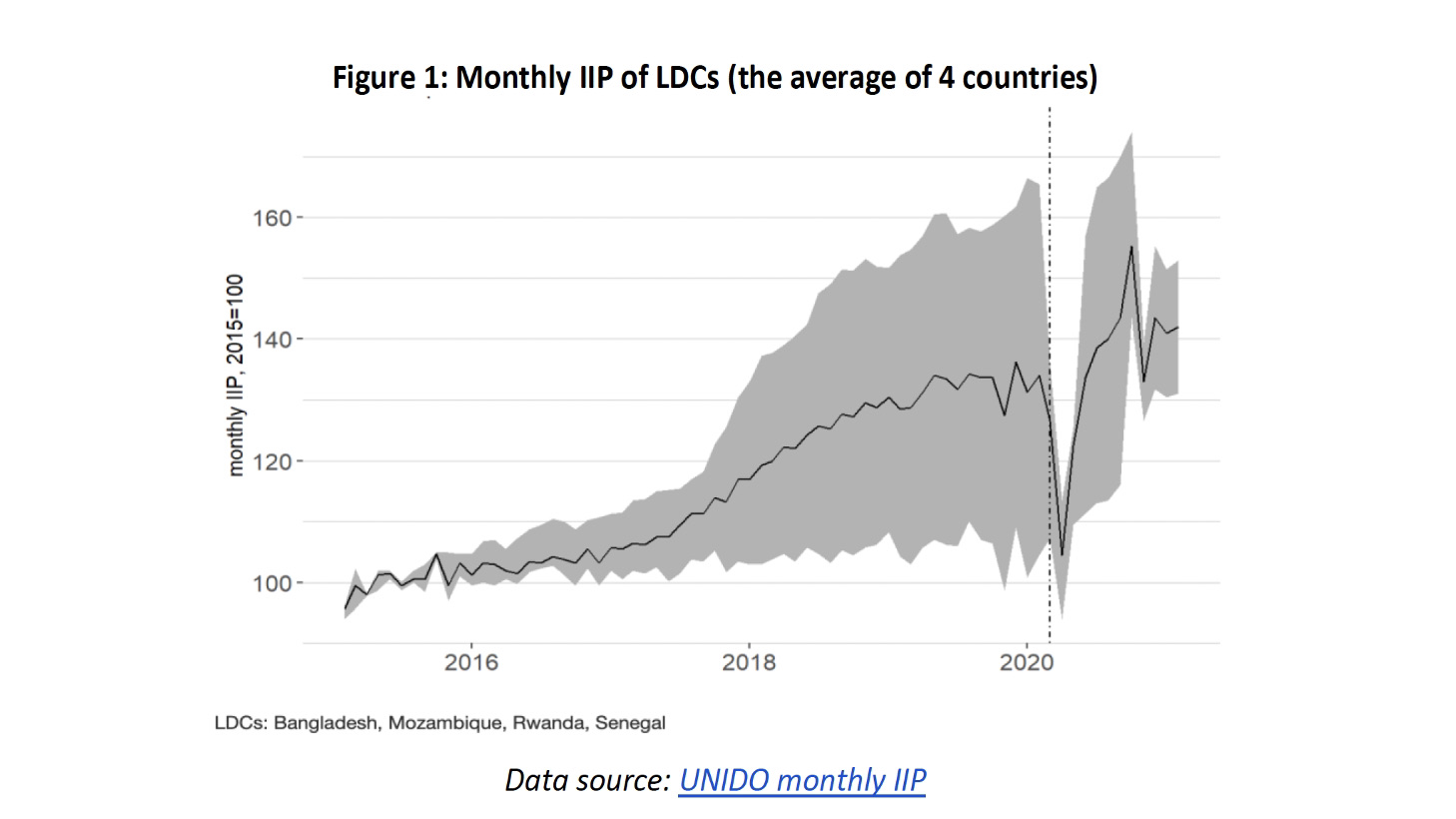

COVID-19 pandemic: threats to SMEs in poorest nations require swift policy action
22 June 2021 Frank Hartwich and Jenny Larsen

By Frank Hartwich and Jenny Larsen
Despite the overwhelming dominance of services in the world economy, the manufacturing sector continues to punch above its weight. It remains a main driver of the productivity growth needed to spur technological change and innovation, essential for both job creation and well-being. This is especially true for developing countries, making industrialization a crucial part of efforts to achieve the Sustainable Development Goals (SDGs).
We should therefore be concerned about signs emerging in the world’s poorest countries. Data sets are scarce, but there is evidence to suggest that the COVID-19 pandemic has had a severe impact on small and medium-sized enterprises (SMEs) and on the informal sector in least developed countries (LDCs). Without swift action from governments and the international community to get key industrial sectors back on track, a protracted downturn may be on the cards, with knock-on effects on development and efforts to cut poverty.
Factories around the world roared into action again in the second half of 2020, following the COVID-19-related slump that brought large parts of industrial production to a standstill in early 2020. The bounce back, led by Europe, China and other parts of Asia, has been faster than expected, with most of the losses felt in the first half of 2020 recovered by early 2021, although there are big differences between regions and sectors.
Using the limited data available, it appears that manufacturing in selected LDCs has also staged a recovery. UNIDO’s Index of Industrial Production (IIP) – only available for four of the 46 LDCs – showed a dramatic drop in the early part of 2020, followed by a sharp rise in early 2021, although a closer look at the data reveals a nuanced picture. Mozambique and Senegal saw little impact from the pandemic whereas in Bangladesh and Rwanda the effects were much stronger. In general, within low-tech industries which predominate in LDCs, the food industry benefitted from the pandemic while other sectors such as textiles, clothing and leather were hit particularly hard.

SMEs make up the majority of industries in LDC economies and it is likely that due to their limited access to financial and government support measures, they have been far less successful in coping with COVID-19-related lockdowns and the drop in supply and demand.
This is confirmed by the recent UN report on the impact of COVID-19 on LDCs and by a World Trade Organization (WTO) study on trade impacts of LDC graduation. The results of both studies follow World Bank research published in late 2020, which found that COVID-19 has affected SMEs in a myriad of ways, including smaller firms seeing their sales dwindle faster compared with large firms in the same sector and country, which in turn has put a bigger drain on cash flows.
Looking back to earlier in the pandemic, the International Trade Centre (ITC) reported that in Africa, which is home to 33 LDCs, two out of three businesses had been strongly affected by COVID-19, mostly involving reduced sales (75 per cent of firms) and/or difficulty accessing inputs (54 per cent of firms).
Digging deeper, there are winners and losers. Some better prepared firms, especially larger concerns, have weathered the storm by managing their inputs and switching suppliers, and are now on the road to recovery. Those backed by international companies have also done better as they have been able to avoid cash flow problems and maintained easier access to international markets.
But for smaller, locally operated firms the overall picture is worrying. Many have filed for bankruptcy or are facing costly credit bills to stay afloat. Smaller firms and those operating in the informal economy, which are both important contributors to industrial production in LDCs, are likely to have been worst affected as a whole, as has been reported in numerous media articles in LDCs themselves.[1] In some cases, unable to compete on quality or resources, they may have been crowded out by larger firms. Many may also have missed out on support measures such as wage subsidies and tax relief, which rarely find their way to the informal sector. On the other hand, some micro businesses operating in the informal sector may have benefitted from continuing to operate below the radar, filling the gap left by formalized smaller companies which are suffering from supply, sales and credit crunches.
For countries in fragile and conflict-affected situations, as classified by the World Bank, the International Finance Corporation (IFC) has found that the compounded impact of demand crises, disruptions to transportation and value chains, and limited availability of credit have been forcing micro, small, and medium enterprises (MSMEs) to cease operations, which increases the number of non-performing bank loans and threatens the stability of the financial systems in these nations.

The precarious position of many SMEs in the poorest countries was also confirmed by speakers at a UNIDO event in late May, organized as part of preparations for the forthcoming United Nations Conference on LDCs in January 2022.
Paul Makanza, Chairman of the Confederation of Tanzanian Industries, said that in Tanzania SMEs “had taken the brunt of the impact”, and called for a dedicated SME policy to help get the sector back on its feet, while Albert Muchanga, African Union Commissioner for Trade and Industry, noted that the sharp downturn in 2020 had left much industrial capacity idle, particularly in landlocked African LDCs where productive capacity had fallen markedly since the crisis.
Widespread indications that the vital SME sector has been hit hardest by the pandemic – and in some cases may be unable to recover – will add to the broader impacts of the crisis. A sharp fall in external demand, sinking commodity prices, a dramatic fall in tourism, rising debt, lower remittances and a severe cut in foreign direct investment have caused the worst recession in 30 years in LDCs, leaving governments more indebted and fiscally weaker. That means that, despite so far having escaped the worst direct effects of the pandemic, LDCs will struggle to recover in the short to medium term.
What should LDCs do?
Governments must walk a fine line between taking action to save existing industrial firms and putting in place longer-term measures that build back better with more resilient industries, more able to resist shocks such as pandemics.
Key policies that could drive the inclusive and sustainable industrial development necessary to achieve greater resilience are:
In short, the private sector must be able to adapt to the new post-COVID reality, finding new markets and developing higher-value products. But this should be underpinned by strategic support from government, directing finance to develop technology and encourage business development.
Given the perilous financial situation in most LDCs, this will require action from both national governments and the international community to ensure that industrial policies form part of national and regional recovery plans, perhaps through devising a common framework for the transformation and diversification of LDC economies.
Without it, the vulnerabilities of LDC economies, revealed more clearly by the pandemic and compounded by the current lack of access to COVID-19 vaccines, risk becoming entrenched, pushing development goals further out of reach.
[1] Covid-19 fallout: Informal sector hit hard by second wave , Africa Industrialisation Day: how to support African manufacturing during the Covid-19 recovery, Covid-Hit SMEs Bitter Over Lack Of Govt Support ,Emergency Response for Artisanal and Small-Scale Mining Communities Impacted by COVID-19